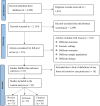Variations in definitions used for describing restrictive care practices (seclusion and restraint) in adult mental health inpatient units: a systematic review and content analysis
- PMID: 39080007
- PMCID: PMC11790767
- DOI: 10.1007/s00127-024-02739-6
Variations in definitions used for describing restrictive care practices (seclusion and restraint) in adult mental health inpatient units: a systematic review and content analysis
Abstract
Purpose: The main purpose of this review was to (1) identify thematic elements within definitions used by recently published literature to describe the constructs of physical/mechanical restraint, seclusion and chemical restraint in adult mental health inpatient units.
Methods: We conducted a comprehensive literature search of six databases (Scopus, MEDLINE, PsycINFO, Web of Science, Embase, and CINAHL-Plus). In this review, we conducted content analysis to synthesize evidence to understand and compare the commonalities and discrepancies in conceptual elements that were incorporated within the definitions of different forms of restrictive care practices.
Results: A total of 95 studies that provided definitions for different forms of restrictive care practices [physical/mechanical restraint (n = 72), seclusion (n = 65) and chemical restraint (n = 19)] were included in this review. Significant variations existed in the conceptual domains presented within the applied definitions of physical/mechanical restraint, seclusion, and chemical restraint. Conceptual themes identified in this review were methods of restrictive care practice, reasons and desired outcomes, the extent of patient restriction during restrictive care practice episodes, timing (duration, frequency, and time of the day), the level of patient autonomy, and the personnel implementing these practices.
Conclusions: Inconsistencies in the terminologies and conceptual boundaries used to describe the constructs of different forms of restrictive care practices underscore the need to move forward in endorsing consensus definitions that reflect the diverse perspectives, ensuring clarity and consistency in practice and research. This will assist in validly measuring and comparing the actual trends of restrictive care practice use across different healthcare institutions and jurisdictions.
Keywords: Classification; Coercion; Definition; Immobilization; Mental health; Perception; Restraint; Restrictive practice; Seclusion; Understanding.
© 2024. The Author(s).
Conflict of interest statement
Declarations. Competing interests: The authors declare no competing interests.
Figures


Similar articles
-
Methodological Issues in Measuring Restrictive Care Practices (Mechanical/physical restraint, Chemical restraint and Seclusion) in Adult Mental Health Inpatient Units: A Systematic Review of Recent Literature.J Clin Nurs. 2025 May;34(5):1629-1647. doi: 10.1111/jocn.17588. Epub 2024 Dec 9. J Clin Nurs. 2025. PMID: 39653688
-
Prevalence and variability of restrictive care practice use (physical restraint, seclusion and chemical restraint) in adult mental health inpatient settings: A systematic review and meta-analysis.J Clin Nurs. 2024 Apr;33(4):1256-1281. doi: 10.1111/jocn.17041. Epub 2024 Feb 2. J Clin Nurs. 2024. PMID: 38304928
-
Risk factors associated with use of coercive practices in adult mental health inpatients: A systematic review.J Psychiatr Ment Health Nurs. 2022 Apr;29(2):220-239. doi: 10.1111/jpm.12757. Epub 2021 Apr 20. J Psychiatr Ment Health Nurs. 2022. PMID: 33835622
-
Reducing seclusion and restraint in an acute adolescent psychiatric ward: A feasibility study.J Psychiatr Ment Health Nurs. 2024 Aug;31(4):451-461. doi: 10.1111/jpm.13000. Epub 2023 Dec 7. J Psychiatr Ment Health Nurs. 2024. PMID: 38059413
-
"Treat me with respect". A systematic review and thematic analysis of psychiatric patients' reported perceptions of the situations associated with the process of coercion.J Psychiatr Ment Health Nurs. 2017 Nov;24(9-10):681-698. doi: 10.1111/jpm.12410. Epub 2017 Sep 12. J Psychiatr Ment Health Nurs. 2017. PMID: 28665512
Cited by
-
Diminishing restrictive practices in psychiatric wards via virtual reality training: Old wine in a new bottle?World J Psychiatry. 2024 Dec 19;14(12):1783-1787. doi: 10.5498/wjp.v14.i12.1783. eCollection 2024 Dec 19. World J Psychiatry. 2024. PMID: 39704365 Free PMC article.
-
Factors involving in healthcare professionals' decision-making process regarding the use of restrictive care practices in adult mental health inpatient units: A protocol for an umbrella review.PLoS One. 2025 Feb 24;20(2):e0319228. doi: 10.1371/journal.pone.0319228. eCollection 2025. PLoS One. 2025. PMID: 39992991 Free PMC article.
References
-
- Lickiewicz J, Adamczyk N, Hughes PP, Jagielski P, Stawarz B, Makara-Studzińska M (2021) Reducing aggression in psychiatric wards using Safewards—A Polish study. Perspect Psychiatr Care 57(1) - PubMed
-
- Kawai Y, Hamamoto M, Miura A, Yamaguchi M, Masuda Y, Iwata M, Kanbe M, Ikematsu Y Prevalence of and factors associated with physical restraint use in the intensive care unit: a multicenter prospective observational study in Japan. Intern Emerg Med 2021:1–6 - PubMed
-
- Wilson C, Rouse L, Rae S, Kar Ray M (2017) Is restraint a ‘necessary evil’in mental health care? Mental health inpatients’ and staff members’ experience of physical restraint. Int J Ment Health Nurs 26(5):500–512 - PubMed
-
- Gaskin C (2013) Reducing restrictive interventions: literature review and document analysis. Department of Health and Human Services, Melbourne, Vic
Publication types
MeSH terms
LinkOut - more resources
Full Text Sources
Medical

